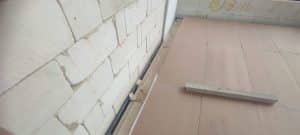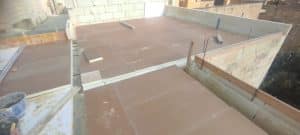When installing underfloor heating sheets, one crucial factor that’s often overlooked—but absolutely essential—is floor thickness. If you’ve ever wondered how thick should floor be for underfloor heating sheet, you’re not alone. It’s a common question among homeowners and builders in Malta aiming to upgrade their heating systems for comfort, efficiency, and sustainability.
Getting the right floor thickness ensures not only the system’s performance but also your safety, energy savings, and durability over time. Let’s explore the exact answer and dive into the layers of what makes the perfect floor build-up when using underfloor heating sheets.
✅ What’s the Ideal Floor Thickness for Underfloor Heating Sheets?| How Thick Should Floor Be for Underfloor Heating Sheet
So, let’s address the core question directly: How thick should floor be for underfloor heating sheet?
In general, the recommended floor thickness for underfloor heating sheet installations ranges from 50mm to 100mm, depending on the specific floor build-up and type of construction. For suspended timber floors, the thickness can be less, while concrete subfloors usually require a thicker build-up.
Here’s a typical layer breakdown in Malta homes using electric underfloor heating sheets:
| Layer | Typical Thickness |
|---|---|
| Floor covering (tile, wood, etc.) | 10–15mm |
| Adhesive or screed layer | 5–15mm |
| Underfloor heating sheet | ~2–3mm |
| Insulation layer | 6–20mm |
| Concrete or screed subfloor | 40–75mm |
| Total Thickness | ~60–100mm |
🔧 If you’re retrofitting a system into an existing home, low-profile systems can reduce the need for full-depth excavation or heavy screeds. These systems are designed to be ultra-thin, often adding as little as 18mm to the overall floor height—perfect for older Maltese homes with stone or concrete foundations.
🛠️ Why Floor Thickness Matters More Than You Think| How Thick Should Floor Be for Underfloor Heating Sheet
You might be tempted to think, “Does a few millimetres here or there really matter?”
Yes—it absolutely does. Here’s why getting the floor thickness right is non-negotiable when installing underfloor heating sheets:
1. Thermal Performance| How Thick Should Floor Be for Underfloor Heating Sheet
A floor that’s too thick, especially with poor insulation, will take longer to heat up and cool down. On the other hand, a floor that’s too thin may not hold the heat long enough, reducing system efficiency. A well-calculated thickness ensures heat is retained and evenly distributed across your room.
2. Energy Efficiency| How Thick Should Floor Be for Underfloor Heating Sheet
In Malta’s moderate winters, energy efficiency is key. If you build your floor too thick without proper thermal insulation beneath, your heating system will burn through electricity to warm up unnecessarily deep layers. This increases your energy consumption—and your monthly bills in euros.
3. Structural Integrity| How Thick Should Floor Be for Underfloor Heating Sheet
The floor needs to be strong enough to support furniture, foot traffic, and general wear and tear. A concrete screed that’s too thin can crack, especially when heating sheets expand and contract with thermal cycling.
4. System Lifespan| How Thick Should Floor Be for Underfloor Heating Sheet
A poorly calculated floor depth can cause overheating, component stress, or uneven temperature zones. Over time, this can reduce the life expectancy of your underfloor heating sheet system.
🧱 Floor Build-Up Options in Malta: From Renovation to New Builds| How Thick Should Floor Be for Underfloor Heating Sheet
The type of property you’re working on makes a big difference in how thick your floor needs to be.
🔹 New Builds
In new construction, there’s more flexibility. You can plan floor depth ahead of time, integrate insulation directly under the slab, and use standard or thick screeds. In this case, a full 75mm+ floor thickness is totally manageable.
🔹 Renovations and Retrofits
For older Maltese townhouses, farmhouses, or apartments, you might be working with stone or irregular subfloors. Here, low-profile underfloor heating sheets are the perfect solution. With specialized insulation boards and ultra-thin heating mats (some as thin as 1.8mm), you can keep the floor thickness as low as 30–40mm total.
Many systems in Malta also allow floating floor installations, which do not require screeds and can sit directly under laminate or engineered wood flooring.
📞 Not sure what your property allows? Contact us here and we’ll help you assess your current floor structure and suggest the right underfloor heating sheet system and floor thickness.
🔍 How to Calculate Floor Thickness for Your Project| How Thick Should Floor Be for Underfloor Heating Sheet
Let’s walk through a quick example of how to calculate how thick should floor be for underfloor heating sheet in a typical Maltese home.
💡 Scenario:
You’re renovating a 20m² kitchen in Malta and want to install ceramic tiles over underfloor heating sheets.
📐 Calculation:
Tile: 10mm
Tile adhesive: 5mm
Heating sheet: 2.5mm
Insulation board: 10mm
Levelling screed: 20mm
Total thickness: 47.5mm (~48mm)
This is well within acceptable standards and requires minimal floor height adjustment. If you’re working with doors, skirting, or cabinet heights, this small increase is usually easy to accommodate.
However, for larger spaces or commercial properties, you might want to use a thicker screed for even heat distribution and structural support, potentially bringing the total up to 70–80mm.
If your existing floor can’t handle that? Don’t worry—low-profile solutions are available that add as little as 20mm of build-up.
💶 Cost Considerations: How Floor Thickness Impacts Your Budget| How Thick Should Floor Be for Underfloor Heating Sheet
Floor thickness not only affects installation time but also your final invoice.
Thinner Systems (30–50mm Total)
Ideal for renovations
Lower material costs
Quicker installation
Estimated cost: €50–€80/m²
Thicker Systems (75–100mm Total)
Ideal for new builds
Longer heating retention
Stronger and more durable
Estimated cost: €75–€110/m²
Keep in mind: thinner floors heat up faster but may lose warmth more quickly if not properly insulated. Thicker floors are slower to heat, but they radiate heat for much longer—making them perfect for consistent use in living rooms or bedrooms.
💡 Want a quote tailored to your floor type and property size in Malta? Reach out to us directly here.
🌡️ The Role of Insulation in Floor Thickness| How Thick Should Floor Be for Underfloor Heating Sheet
Insulation isn’t optional—it’s essential.
If you skip insulation or use the wrong material, your heating system will work inefficiently, wasting both heat and money. Insulation helps direct the heat upward into the room, rather than letting it seep down into the concrete slab.
Common insulation types in Malta:
XPS Boards (extruded polystyrene): Durable, moisture-resistant
Cement-coated EPS: Great for tiled floors
Multifoil: For ultra-thin, reflective insulation
Most boards are between 6mm and 20mm thick and are installed beneath the heating sheets. The exact thickness depends on your floor’s existing condition and the heating system type.
📢 Fun fact: Well-insulated floors can cut energy costs by up to 25% compared to non-insulated ones. That’s money saved in every Maltese winter.
🧩 Best Flooring Materials to Use with Underfloor Heating Sheets| How Thick Should Floor Be for Underfloor Heating Sheet
Now that we’ve answered how thick should floor be for underfloor heating sheet, let’s talk about compatibility. Not all floor coverings perform equally when used with underfloor heating sheets. Some materials conduct heat efficiently, while others act as insulators and reduce performance.
✅ Best Flooring Types:
Ceramic or Porcelain Tiles
Excellent thermal conductivity
Ideal for kitchens and bathrooms
Can handle thicker floors (60–80mm total buildup)
Engineered Wood Flooring
Suitable for low-profile systems
Stable under heat and humidity
Works well with floor thicknesses of 40–60mm
Luxury Vinyl Tiles (LVT)
Thin and flexible
Great for retrofits
Works well with underfloor heating when floor buildup is limited to ~30mm
Laminate Flooring
Good budget option
Requires low moisture and low-heat compatibility
⚠️ Flooring to Avoid:
Solid Hardwood: Can warp due to heat and moisture
Thick Carpeting: Acts as an insulator and slows down heat transfer
Natural Stone Without Proper Insulation: Might feel cold if insulation isn’t included beneath
Always follow the manufacturer’s guidelines for maximum temperature tolerances (usually 27–29°C surface temperature).
⚠️ Common Floor Thickness Mistakes to Avoid| How Thick Should Floor Be for Underfloor Heating Sheet
Even with all the planning in the world, floor thickness errors can happen—and they’re costly. Here are the most common mistakes homeowners and contractors in Malta make when figuring out how thick should floor be for underfloor heating sheet.
1. Ignoring Floor Height Restrictions
Especially in apartment buildings or townhouses, door clearances, ceiling heights, and stair risers must be taken into account. A few extra millimetres can throw off your interior flow.
2. Skipping Insulation
This can’t be said enough: skimping on insulation beneath the heating sheet forces the system to heat unnecessarily deep floor layers, wasting electricity and lowering performance.
3. Installing Without Levelling
Uneven screeds or floors lead to hot and cold patches. A flat floor build-up ensures full contact between your heating sheet and top layer for even warmth distribution.
4. Over-Thick Screeds
Some believe “thicker screed = better,” but this isn’t always true. Overly thick screeds can delay heat-up time by hours, making the system feel sluggish—especially in short-use areas like bathrooms.
🌍 Malta-Specific Considerations for Underfloor Heating Floors| How Thick Should Floor Be for Underfloor Heating Sheet
Living in Malta presents some unique challenges and opportunities for floor heating systems. Here’s how local factors impact floor thickness and performance:
🔸 Humid Coastal Conditions
Humidity and salt air can affect flooring adhesives and subfloor integrity. For homes near the coast, use moisture-resistant insulation and polymer-modified adhesives to maintain structural soundness.
🔸 Stone and Concrete Base Floors
Many older Maltese homes use limestone, terrazzo, or concrete bases. These are ideal for embedding underfloor heating sheets as long as proper insulation boards are used beneath the system.
🔸 Lack of Central Heating
Because central heating is rare in Malta, underfloor systems are often the main source of heat, not just supplemental. This means floor thickness must be calculated to ensure both comfort and efficiency, not just occasional use.
🔸 Cooling Considerations
Some underfloor systems offer cooling as well. In these cases, screed depth and thermal response matter even more. We recommend a floor thickness range of 60–80mm for combined heating and cooling setups.
🧼 Maintenance Tips for Long-Lasting Floors with Heating Sheets| How Thick Should Floor Be for Underfloor Heating Sheet
Once your floor is built at the right thickness and your underfloor heating sheets are installed, it’s important to maintain both the surface and system. A well-maintained floor ensures you continue to enjoy optimal performance for years.
🛠️ Top Tips:
Use Floor-Safe Cleaning Products: Avoid harsh chemicals that may seep into screeds or weaken adhesives.
Check Floor Sensors Annually: Some systems include thermostatic floor sensors that monitor temperature.
Don’t Drill Into Heated Zones: Always consult your floor plan before any renovations.
Bleed Air from Adjacent Heating Systems: If you’re combining with radiators or boilers, ensure systems aren’t competing.
Routine inspections and thermostat calibration help keep everything running smoothly, especially in Malta’s fluctuating humidity.
🔁 Upgrading or Replacing Existing Heating Floors| How Thick Should Floor Be for Underfloor Heating Sheet
Already have a floor heating system and wondering if you can upgrade or improve its insulation or floor build-up?
The good news is: yes!
You can often upgrade without tearing everything out. Many homes in Malta that were fitted with older cable-based heating mats can be retrofitted with ultra-thin underfloor heating sheets. These add less than 5mm in total and allow modern digital thermostats, smart controllers, and Wi-Fi functionality.
Additionally, you may be able to add thin insulation overlays or a levelling compound to improve heat distribution and reduce warm-up times.
📞 Contact Us Today to Get Your Project Started!| How Thick Should Floor Be for Underfloor Heating Sheet
If you’re still asking yourself how thick should floor be for underfloor heating sheet, the answer depends on your home, flooring choice, and usage habits.
But you don’t have to figure it out alone.
👉 Our team at Kibitec can help you design the perfect system—with the right thickness, the right materials, and the right heating control.
➡️ Contact us now for a personalized assessment and quote in Malta.
Whether you’re doing a full home renovation or upgrading one room, we’ll make sure your underfloor heating sheet system is efficient, comfortable, and built to last.
🔍 Check Out Our Underfloor Heating Sheet Services in Malta| How Thick Should Floor Be for Underfloor Heating Sheet
Want to learn more about how we can help?
➡️ Check out our full underfloor heating sheet service page here
From supply to installation, we deliver high-performance systems designed for the unique climate and architecture of Malta.
🔗 Learn More About Underfloor Heating Technology| How Thick Should Floor Be for Underfloor Heating Sheet
Still curious? Dive into the technical background of underfloor heating to better understand how radiant heat works through floor surfaces, and why floor thickness plays such a vital role in efficiency and comfort.
📌 Final Takeaway: Thickness Isn’t Just a Number—It’s the Foundation of Comfort| How Thick Should Floor Be for Underfloor Heating Sheet
In conclusion, how thick should floor be for underfloor heating sheet isn’t a one-size-fits-all answer. But with the right guidance, materials, and planning, you can achieve a floor that’s:
Warm and even
Energy-efficient
Comfortable underfoot
Long-lasting and safe
Whether you’re building a new home or upgrading a cozy corner of your Maltese property, floor thickness could be the deciding factor between a toasty oasis and a costly, underperforming system.
📩 Don’t leave it to guesswork—contact us today and let’s build comfort from the ground up.




